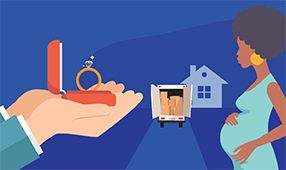It’s difficult enough to buy a house when U.S. home prices and mortgage rates are rising, but it can be even more challenging on a teacher’s salary.
Research by the National Housing Conference (NHC), a nonprofit housing advocacy group, finds that teachers’ salaries often fall short of the income needed to buy a home in many metropolitan areas. For example, in Phoenix, which continues to see some of the steepest home-price increases in the country, a high school teacher earns a median salary of $54,190 but would need an income of $117,128 and a 10% down payment to buy a home there, according to NHC.1
“As with the case of most first-time homebuyers, teachers face significant hurdles coming up with the down payment that is large enough to make their mortgage payment affordable,” says David Dworkin, NHC president. “And for some teachers, it’s difficult to come up with a minimum payment at all because the housing market that they live in is so unaffordable.”
Fortunately, there are a variety of homebuyer assistance programs designed with teachers and first-time homebuyers in mind. Some programs lower closing costs; others help with the down payment. One government program even slashes the price of a house. And if you need a mortgage to help cover some or all of your purchase, NEA members have access to a great home loan benefit.
Let’s take a closer look at a few of these homeownership assistance and teacher mortgage programs.
Good Neighbor Next Door
This U.S. Housing and Urban Development (HUD) program offers a deal that’s hard to beat: 50% off the price of single-family homes being sold by HUD.
HUD acquires foreclosed houses after borrowers default on mortgages insured by the Federal Housing Administration (FHA). The houses, sold as-is, are in HUD-designated “revitalization areas” in need of economic and community development. You can search for available houses online.
The program is open to full-time pre-kindergarten to 12th grade teachers working in the revitalization area, as well as other public service workers.
For their part, homebuyers agree to live in the house as their sole residence for up to three years and remain employed in their profession for at least one year. HUD holds a second mortgage on the house for the amount of HUD’s discount. However, you won’t owe interest or make payments on this loan, which disappears once the three-year residency requirement is met.
You can use any type of mortgage to pay for the other half of the house. Although with an FHA mortgage, participants in Good Neighbor Next Door can put down as little as $100, instead of the usual 3.5% down payment.
A key drawback: The inventory of homes available through this program may be severely limited, and competition can be fierce. You generally have seven days to make a bid. If there are multiple bids, the winner is chosen by lottery.
State and local homebuyer assistance programs
You might have more success with one of the many programs from states and municipalities that are potentially worth thousands of dollars in down payment and closing cost assistance on the purchase of a primary residence.
These programs are often offered by housing and development agencies and used in conjunction with an approved mortgage program. You can find them online by searching for “home buyer assistance” or “down payment assistance” in your state or municipality.
“They’re underutilized. Not a lot of people know about them,” says Kate Wood, a home and mortgage expert at NerdWallet, a personal finance site.
Some are geared for teachers, but most target first-time home buyers. “If you haven’t had an ownership interest in a home in the last three years, most of these will consider you to be a first-time home buyer,” Wood says. “It encompasses a larger group of people than you might think.”
Assistance varies: Some are home-buying grants that don’t have to be repaid. Others are zero- or low-interest loans that have no monthly payment and are forgiven once a buyer lives in the home for a set number of years. Some loans only need to be repaid when the property is refinanced or sold.
For example, Illinois offers a loan of up to $6,000 for down payment and closing costs that’s forgiven over 10 years. In designated parishes, Louisiana provides an interest-free loan of up to $55,000 toward the purchase of a house plus up to $5,000 for closing costs that’s fully forgiven after the buyer lives in the house for 10 years. First-time homebuyers in New York City may qualify for an interest-free, forgivable loan of up to $100,000 for the down payment or closing costs on a principal residence in the city.
Details vary depending on the program, but in general, income limits apply, and you’re required to take a homebuyer education course. And although you must work with a participating lender, you usually have multiple choices so you can shop around for the one that offers the best interest rate, Wood says.
Teacher Next Door
This private program is one-stop shopping, from finding teacher home-buying grants or loans that help with your home purchase to connecting you with a real estate agent and lender in its network.
As the name implies, it’s designed for teachers but includes other school employees, such as administrators, custodians, nurses, office staff and bus drivers. (Firefighters, police and other public service workers also are eligible.)
When you apply, a program specialist identifies any public and private home-buying assistance you may be eligible for. Teachers could receive up to $8,000 in grants and payment assistance of up to $10,681, according to the program.
The Teacher Next Door program also works with two lenders that can pre-approve you for a mortgage, which can make your offer to a seller more attractive. And it has a network of more than 13,000 real estate agents nationwide to help you find a home, says co-founder Steve Parks.
Teachers also may be eligible for discounts on inspections, title insurance and other services purchased through one of Teacher Next Door’s partners.
Teacher Next Door launched during the 2008 financial crisis and continues to assist educators in achieving their dream of homeownership. “We started small, and it’s exceeded our expectations,” says Parks, noting the program currently receives about 10,000 applications a month.
Homes for Heroes
This for-profit company, launched after Sept. 11, 2001, offers discounts and rebates on home-buying services to a whole list of deserving heroes that includes teachers from pre-K to college.
The more services you purchase from program’s partners, the more you save. The company says homebuyers on average save $1,700 on real estate broker fees, $500 on mortgage lender fees, $150 on title service, and $50 on a home inspection.
Landed
For many teachers, the down payment is one of the biggest hurdles to home ownership, particularly in an expensive market. That’s where Landed comes in.
The private program helps educators come up with a 20% down payment in exchange for a share of the profit when the house is later sold.
A 20% down payment makes your offer more attractive, and it decreases the size of your monthly mortgage payments, says Daniel Anderson, a real estate agent and retired high school teacher in Portland, Oregon. It also allows you to forgo paying for private mortgage insurance (PMI), which protects the lender if you default on your loan. (On a $300,000 loan, PMI can run $1,500 to $4,500 a year.)
Here’s how Landed works: Buyers contribute at least 5% to the down payment. Landed provides a no-interest loan for as much as 15% of the home price (up to $120,000 or $150,000, depending on the market).
What does Landed get in return? A repayment of the loan plus a share of the profit – or loss if home values fall – generally when the buyer sells the house or refinances. For every 1% Landed contributes to the down payment, it shares in 2.5% of the gain or loss. So, if Landed contributes 8%, its share is 20%. At 15%, Landed’s share is 37.5%.
“If [homeowners] are building equity, even if they have to share it, that’s much better than living in an apartment and no equity,” says Anderson, who is one of Landed’s participating agents.
The program tends to be available only in expensive markets, such as Miami, San Francisco, and Washington, D.C., that are most likely to appreciate in value. See if Landed is available in your area.
FNBO Home Mortgage Program for NEA members
Teachers getting a mortgage through this NEA member benefit program don’t pay any loan application, processing or origination fees―an estimated savings of $1,195.
The First National Bank of Omaha (FNBO) offers a range of mortgage loan types from conventional to FHA, VA and USDA loans in all 50 states. A bank loan officer will review your finances and goals to find the best mortgage for you as well as walk you through the process, says Eric Johnson, FNBO’s director of consumer direct mortgages.
With home prices rapidly rising and demand still soaring, buyers can get caught up in a bidding war, Johnson says. He advises buyers to set a price range for a house that fits their budget and allows them to meet their long-term goals. “We tell them, ‘Stay to your plan,’ ” he says. “You don’t want to be overly invested in a property.”
Plus, when considering how much house you can afford, don’t forget to budget for ongoing housing expenses, such as maintenance, property taxes and homeowners insurance. Check the NEA Auto & Home Insurance Program to find affordable homeowner coverage. And read 5 Unexpected Costs of Homeownership to plan ahead to avoid overextending your budget.
1 S&P Corelogic Case-Shiller Index Shows Annual Home Price Gains Increased to 19.8% in February, S&P Dow Jones Indices, April 26, 2022. Paycheck to Paycheck, National Housing Conference, 2022.












